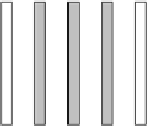Environmental Engineering Reference
In-Depth Information
17.13 COMPOSITION OF FILTERING MATERIALS
FOR ATMOSPHERIC MONITORING
Sampling for capturing and subsequent analysis of aerosols and substances present in the atmo-
sphere simultaneously as aerosols and gases one should conduct using a row of sequentially placed
ilters and SFMs (Figure 17.15).
The irst three ilters are required for the determination of aerosol size distribution via multilayer
iltering method. The subsequent SFM layers are intended for determination of gaseous components.
One can vary the number of ilters in a package. So, ilter 3 may consist of several layers to
exclude aerosols penetration onto adsorbing layers, that is, aerosols are to be captured not by four
ilters as it is shown on Figure 17.15 but by more ilters. On the other hand, if a gaseous substance
is captured with high effectiveness by one SFM layer, there is no need using a greater number of
layers. On the contrary, if gaseous substances are captured with insuficient effectiveness as it is
in case of presence of poorly adsorbed iodine compounds, one may require greater SFM number
(4-6) for separation of gaseous forms into different fractions. Sorbent content in each of the SFM is
2-10 mg/cm
2
depending on its grade.
Using such packages allows determining after measuring of the captured substance at each ilter
all basic characteristic of gaseous-aerosol system including size distribution of aerosols and correla-
tion between aerosol and gaseous components of contaminating substances.
In a number of cases such ilter package is a simple, effective, and cheap way to get authen-
tic information about characteristics of aerosols. We stress once more that when operating this
method instruments and installations are used that are intended for routine sampling of aerosols
by ibrous ilters.
17.14 CONCLUSION
Fibrous iltering materials are the most effective means for puriication of gases from suspended
micro- and nanoparticles as well as for sampling of aerosols.
The necessity to develop aerosol iltration theory is driven by its most important practical appli-
cations. Exactly from the iltration theory follows, which iltering materials and ilters are required
for solving this or that problem, how variation of iltration conditions inluences upon the gas puri-
ication grade, life expectancy of ilters, power consumption, etc.
Understanding objective laws of iltration enables to choose analytical ilters that it the purpose
in each concrete case in the best way as well as to determine continuation time period and rate of
sampling, to choose the best method for the analysis of the captured sediment.
Introduction of compositions from different iltering materials enables to determine not only
concentration and chemical (radionuclide) composition of aerosols but also to determine size dis-
tribution of aerosol particles, correlation between aerosol and gaseous components of a substance
under consideration of correction for desorption.
1 2
3
4
5
6
7
8
FIGURE 17.15
Arrangement of ilters for monitoring. 1-3, ilters for size distribution analysis of aerosols; 4,
ilter for prevention of aerosols penetration into adsorbing-iltering materials; 5-7, SFM; 8, protective ibrous
ilter.







Search WWH ::

Custom Search